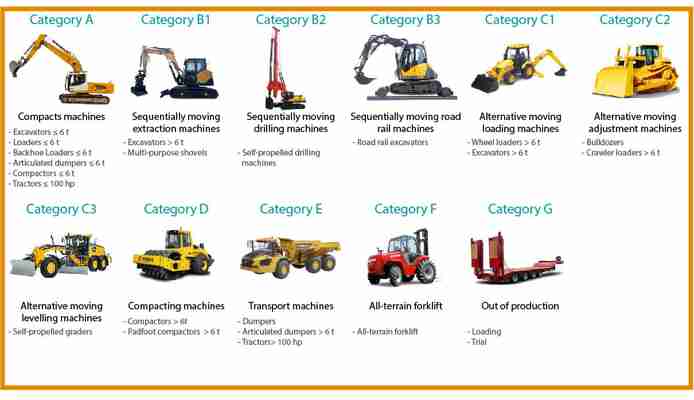The different categories of construction machines

On a construction, renovation, developing, demolition or public works site, construction machines occupy a preponderant place in terms of work tools because of their functions and the many advantages they bring in terms of productivity.
In a modern classification (New R482 standard, page 20 of the document) entry into force in January 2020, construction machines are divided according to their role into 11 categories as follows:
A- Compacts machines : excavators, loaders, backhoe loaders, articulated dumpers, compactors, all with a mass ≤ 6 tonnes.
: excavators, loaders, backhoe loaders, articulated dumpers, compactors, all with a mass ≤ 6 tonnes. B1- Sequentially moving extraction machines : excavators > 6 tonnes, multi-purpose shovels.
: excavators > 6 tonnes, multi-purpose shovels. B2- Sequentially moving drilling machines : self-propelled drilling machines.
: self-propelled drilling machines. B3- Sequentially moving road rail machines : road rail excavators.
: road rail excavators. C1- Alternative moving loading machines : wheel loaders and excavators > 6 tonnes.
: wheel loaders and excavators > 6 tonnes. C2- Alternative moving adjustment machines : bulldozers, crawler loaders > 6 tonnes.
: bulldozers, crawler loaders > 6 tonnes. C3- Alternative moving levelling machines : self-propelled graders.
: self-propelled graders. D- Compacting machines : compactors and padfoot compactors > 6 tonnes.
: compactors and padfoot compactors > 6 tonnes. E- Transport machines : dumpers, articulated dumpers > 6 tonnes, tractors > 100 hp.
: dumpers, articulated dumpers > 6 tonnes, tractors > 100 hp. F- All-terrain handling machines : all-terrain forklift.
: all-terrain forklift. G- Out of production : moving and loading / unloading on machine carrier for demonstration or trial.
The bulldozer: essential construction machine
Among all these machines, the most used arewhose main role is to modify the relief of a land by backfilling or clearing.